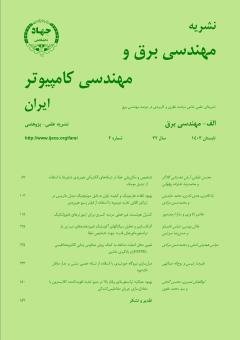تعیین محل اصابت صاعقه به کمک روش معکوس زمانی الکترومغناطیسی(EMTR) و یادگیری ماشین
محورهای موضوعی : مهندسی برق و کامپیوترعباس همدونی اصلی 1 , محمدحسن مرادی 2
1 - دانشكده مهندسی برق دانشگاه بوعلی سینا
2 - دانشكده مهندسی برق، دانشگاه بوعلی سینا
کلید واژه: تعیین محل اصابت صاعقه, تفاضل محدود حوزه زمان, روش معکوس زمانی الکترومغناطیسی, یادگیری ماشین,
چکیده مقاله :
تعیین محل اصابت صاعقه (LLS) از چالشهای امروزی در حوزههای مختلف و بهویژه حوزه برق و الکترونیک است. برای تعیین محل اصابت صاعقه، استفاده از روشهای کلاسیک مرسوم بود؛ ولی اخیراً استفاده از روش معکوس زمانی الکترومغناطیسی (EMTR) نیز رواج یافته است. با توجه به محاسبه شکل موج کامل میدان با استفاده از روش EMTR، دقت در تعیین محل اصابت صاعقه بهطور قابل توجهی نسبت به روشهای پیشین افزایش یافته است. در روش معکوس زمانی الکترومغناطیسی به کمک تفاضل محدود حوزه زمان (FDTD)، ابتدا میدان الکترومغناطیسی گذرای تولیدشده توسط کانال صاعقه محاسبه شده و پس از معکوسکردن زمانی موج، از محل حسگر یا حسگرها به منبع خود بازانتشار میگردد و مجدداً با کمک FDTD، میدان الکترومغناطیسی بازانتشاری در محیط مورد نظر محاسبه میشود. با داشتن میدان الکترومغناطیسی محیط با استفاده از معیارهایی مانند حداکثر دامنه میدان، حداکثر انرژی و آنتروپی و ...، محل اصابت صاعقه تعیین میگردد. در این مقاله روشی بر اساس ترکیب یادگیری ماشین و EMTR برای تعیین محل اصابت صاعقه پیشنهاد شده است. ابتدا روش تفاضل محدود حوزه زمان سهبعدی(D-FDTD3) در محاسبه میدان الکترومغناطیسی محیط بهکار گرفته شد و با استفاده از EMTR میدان الکترومغناطیسی بازانتشاری مجدداً با کمک (D-FDTD3) در کل محیط محاسبه گردید. بدین طریق دادههای لازم برای تولید پروفایلهای سهبعدی تصاویر RGB آماده گردید. سپس برای یادگیری ماشین از VGG19، یک شبکه عصبی کانولوشنی (CNN) از پیش آموزشدیده، برای استخراج ویژگیهای تصاویر استفاده شد. در آخر برای تعیین محل اصابت صاعقه، لایه برازشکنندهای به بالای 19VGG اضافه شد. روش پیشنهادی در MATLAB و Python شبیهسازی و اجرا گردید که نتایج، کارایی آن را برای تعیین محل اصابت صاعقه در محیط سهبعدی نشان میدهند.
Determining the location of lightning strikes (LLS) is one of today's challenges in various fields, especially in the fields of electricity and electronics. To determine the location of the lightning strike, classical methods were used previously; however, the use of electromagnetic time reversal (EMTR) method has also become popular recently. According to the calculation of the complete waveform of the field using the EMTR method, the accuracy in determining the location of the lightning strike has significantly increased compared to the traditional methods. In the electromagnetic time reversal method with the help of finite difference time domain (FDTD), the transient electromagnetic field produced by the lightning channel is calculated first. After the time reversal of the wave, it is re-emitted from the sensor or sensors to its source and again with the help of FDTD, The re-emission electromagnetic field in the desired environment is calculated. With the electromagnetic field of the environment, using criteria (such as maximum field amplitude, maximum energy and entropy, etc.), the location of the lightning strike is determined. In traditional methods, it is quite difficult to determine the uniqueness of the final response in environments with different characteristics, and the use of at least three sensors is mandatory. In this paper, to overcome these limitations, a method based on the combination of machine learning and three-dimensional EMTR (3D-FDTD) is proposed to determine the lightning strike location. First, the three-dimensional time domain finite difference method is used to calculate the electromagnetic field of the environment and using EMTR, the back-diffusion electromagnetic field (again with the help of 3D-FDTD) is calculated in the entire environment. In this way, the necessary data for the production of RGB image profiles is prepared. Then VGG19, a pre-trained convolutional neural network (CNN), is used to extract image features. Finally, a fitting layer is used to determine the location of the lightning strike. The proposed method is simulated and implemented in MATLAB and Python, and the results show the effectiveness of the proposed method to determine the location of lightning strikes in a three-dimensional environment without requiring the use of at least three sensors.


